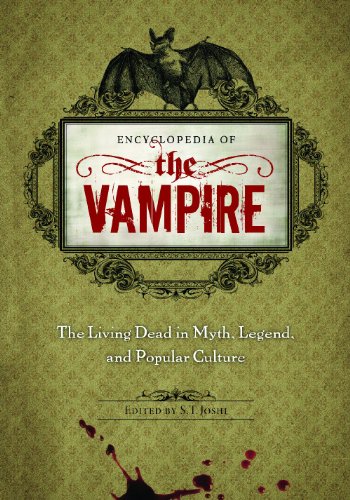 In times past the vampire was discussed largely in folklore, and later horror magazines for monster kids and teens, as well as the cinema, largely for the same audience, including adults who enjoyed the horror genre. While the vampire is still found in these sources, and has appeal for these segments of its audience, the vampire and horror are also increasingly the focus of the academic community.
In times past the vampire was discussed largely in folklore, and later horror magazines for monster kids and teens, as well as the cinema, largely for the same audience, including adults who enjoyed the horror genre. While the vampire is still found in these sources, and has appeal for these segments of its audience, the vampire and horror are also increasingly the focus of the academic community.
An example of the material produced by academics is found in a volumes I have been anticipating for some time. It is the Encyclopedia of the Vampire: The Living Dead in Myth, Legend and Popular Culture (ABC-CLIO/Greenwood, 2010), edited by S. T. Joshi. The publisher describes the book as follows:
This exhaustive encyclopedia covers the full range of topics relating to vampires, including literature, film and television, and folklore.
As the astounding popularity of the Twilight series has proven once again, the terror and romance of the vampire legend continue to cast a supernatural spell over mere mortals. From Bram Stoker’s 1897 classic Dracula to F. W. Murnau’s 1922 silent film Nosferatu to the most recent Hollywood blockbusters, vampires haunt our folklore, bookshelves, and movie theaters.
Encyclopedia of the Vampire: The Living Dead in Myth, Legend, and Popular Culture is a comprehensive encyclopedia relating to all phases of vampirism—in literature, film, and television; in folklore; and in world culture. Although previous encyclopedias have attempted to chart this terrain, no prior work contains the depth of information, the breadth of scope, and the up-to-date coverage of this volume.
With contributions from many leading critics of horror and supernatural literature and media, the encyclopedia offers entries on leading authors of vampire literature (Bram Stoker, Anne Rice, Stephenie Meyer), on important individual literary works (Dracula and Interview with the Vampire), on celebrated vampire films (the many different adaptations of Dracula, the Twilight series, Love at First Bite), and on television shows (Buffy the Vampire Slayer and Angel). It also covers other significant topics pertaining to vampires, such as vampires in world folklore, humorous vampire films, and vampire lifestyle.
Features
• Nearly 240 A-Z entries on all aspects of vampirism
• Photographs and illustrations of vampire films, television shows, and other matters relating to vampires
• Brief bibliographies referring the reader to secondary sources on individual entries
• A general bibliography of scholarship on vampiresHighlights
• Provides the most comprehensive and up-to-date encyclopedia on vampires ever assembled, including books, films, and other material coming out in 2009 and 2010
• Covers vampires in folklore and world culture, as well as in literature, film, and television
• Compiles the work of 41 contributors, including many of the leading authorities on supernatural literature, film, and folklore
• Engages readers with entries written in a lively, accessible manner
One of the contributors to this volume is Matt Cardin, a friend of TheoFantastique who has been interviewed here previously regarding his work in horror and religion. Matt is the author of a few entries in this new encyclopedia, including one titled “Religion and Vampires.” Matt returns to discuss this topic.
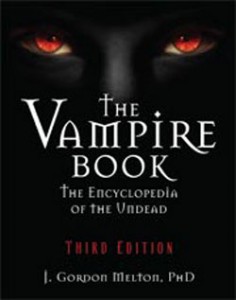 TheoFantastique: Matt, thanks for coming back again to discuss another of your recent projects. Can you tell us a little about the book in which your essay on “Religion and Vampires” appears, your other essays in this volume and how the Encyclopedia of the Vampire makes a contribution beyond works like Gordon Melton’s The Vampire Book and the growing body of academic literature on the vampire?
TheoFantastique: Matt, thanks for coming back again to discuss another of your recent projects. Can you tell us a little about the book in which your essay on “Religion and Vampires” appears, your other essays in this volume and how the Encyclopedia of the Vampire makes a contribution beyond works like Gordon Melton’s The Vampire Book and the growing body of academic literature on the vampire?
Matt Cardin: I think one of the most important things that distinguishes this new book from some of the others in the field is the breadth and nature of its authorship, and also the number of extended essays that accompany and amplify the shorter entries on specific topics. It has more than 40 contributors, and quite a few of them are, like me, not just scholars of horror and the fantastic but practitioners in the field — authors, editors, sometimes both. So that imparts a unique perspective to the whole project.
As for the extended entries, the book features quite a few essays, running to several thousand words each, about everything from vampires in world folklore to the vampire lifestyle to and more.
There’s also the fact that it’s published by Greenwood, an imprint of reference heavyweight ABC-CLIO, which means it’ll end up in pretty much every academic library in the English-speaking world. So this is a point in its favor.
I hasten to add that I don’t personally see it as something that supplants, say, Melton’s book, which is the most obvious one to compare it to, and which is just a brilliant piece of work. I see them all as complementary.
TheoFantastique: What would you say to those who would be either surprised or completely opposed to the legitimacy of the idea of the connection between religion and the vampire?
Matt Cardin: I would say such people haven’t really looked at or thought about the subject very much. Vampires, to put it boldly, are intrinsically religious monsters. They’re bound up with fundamental human questions and fears about personal identity, bodily safety, the fate of the body and soul after death, and so on. This means they entered human culture through the channel of our religious sensibility, broadly defined, and so they automatically carry with them a religious or quasi-religious ambiance.
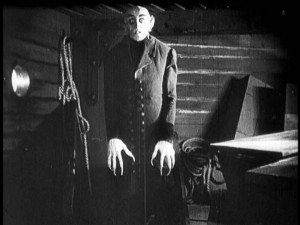 Basically, the vampire is a nexus for an important realm of religious thought and sentiment. It can be read as a kind of “lens” through which the human spiritual impulse has learned to focus itself. Again, if we define religion broadly, then this is all true even when we’re talking about vampires of the particularly nasty and feral sort, like Orlok in Nosferatu or the ones in 30 Days of Night. The very depth of the organic horror they induce throws us up against the limits of what we feel, on a primal and visceral level, is real and acceptable in the universe. And this is pure religious territory.
Basically, the vampire is a nexus for an important realm of religious thought and sentiment. It can be read as a kind of “lens” through which the human spiritual impulse has learned to focus itself. Again, if we define religion broadly, then this is all true even when we’re talking about vampires of the particularly nasty and feral sort, like Orlok in Nosferatu or the ones in 30 Days of Night. The very depth of the organic horror they induce throws us up against the limits of what we feel, on a primal and visceral level, is real and acceptable in the universe. And this is pure religious territory.
TheoFantastique: As I read your piece I was intrigued by your discussion of the major figures of religion who have specialized in the study of the vampire. Can you mention a few of these folks from the past as well as the present?
Matt Cardin: Sure. One of the major points I make in my essay is about the close connection between religion scholarship and vampirology. Basically, the study of vampires came out of the study of religion. The field was pioneered by religion scholars, and has been dominated by them. The earliest was Augustin Calmet, the renowned French Benedictine abbot and theologian who lived in the 17th and 18th centuries and may have been the period’s greatest Catholic biblical scholar. He’s best remembered for writing a book in response to the vampire hysteria that swept across Europe in the 1720s and ’30s. It was published in English as The Phantom World, and was intended to discredit fears about vampires by offering a rational examination of the claims about them. In the process of writing it, Calmet cataloged the entire spectrum of vampiric beliefs that existed at the time.
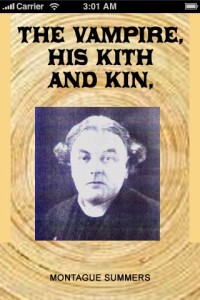 Another major figure was, of course, Montague Summers, whose The Vampire: His Kith and Kin and The Vampire in Europe, both published in the early 20th century, earned him the reputation as the world’s greatest vampire scholar. He was an ordained deacon in the Church of England, and he adopted the pose of a Roman Catholic priest.
Another major figure was, of course, Montague Summers, whose The Vampire: His Kith and Kin and The Vampire in Europe, both published in the early 20th century, earned him the reputation as the world’s greatest vampire scholar. He was an ordained deacon in the Church of England, and he adopted the pose of a Roman Catholic priest.
Later in the 20th century, the eminent French scholar of religion and esotericism Antoine Faivre basically invented the modern field of vampire studies as an independent academic discipline. Not incidentally, this was emphasized in a 2001 essay about him — titled “Antoine Faivre: Father of Contemporary Vampire Studies” — by Massimo Introvigne, the Italian sociologist of religion who is himself a major figure in the vampire field.
This whole line of thought leads me, not incidentally, to a major mea culpa. One of the names you’ve just got to include in a list like this is the aforementioned Gordon Melton, who in addition to being a major American scholar of religion is a major figure in contemporary vampire studies. And I did indeed include him in my essay — but then it came in past the allotted word count, and in the process of editing it down I accidentally removed the reference to him, and failed to notice the mistake until after the book was too far into production to make changes. I know Gordon is a colleague of yours, so I’ll gladly take whatever scolding you want to give me. I just hate that I did that, because he’s one of the guys whose presence reinforces the point that the field of vampires studies has been created and developed by religion scholars.
TheoFantastique: How has the vampire intersected differing religious traditions?
Matt Cardin: A significant portion of our modern-day idea of the vampire was created by Christian institutional religious pressures and practices. Vampires originally had a purely folk-level existence, but then the Church co-opted them and reinterpreted them as minions of the devil. Medieval theologians referred to folk beliefs about vampires to help make the doctrine of transubstantiation — the idea that the eucharistic wine becomes Christ’s blood, and that a believer takes Christ’s spirit into himself by drinking it — comprehensible to a popular audience. When the Roman Catholic Church was trying to expand eastward through the Balkans, it manipulated popular fears for political gain when it warned the local residents that anybody buried on ground that it hadn’t officially consecrated would return as a vampire. The Eastern Orthodox church, for its part, turned into a veritable vampire factory when it overused the punishment of excommunication. This ritually denied burial to a person, and was accompanied by the curse “and the earth will not receive your body,” which playing right into Eastern European fears about incorruptible corpses and the probability that they would become vampires.
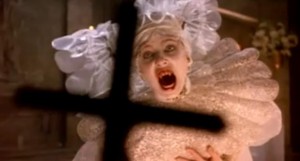 Before all of this happened, vampires followed the logic of folklore more than the logic of religion, even though, like I already pointed out, they were inherently entangled with spiritual and religious-type issues. It was institutional Christianity that gave them the decisive shove toward becoming a formally religious monster. When they crossed over into being a literary monster, too, in the 19th century, thanks to the work of authors like Polidori, Le Fanu, and Stoker, this Christian religious aspect came with them, and was even intensified and codified more than before. The result is that today we don’t even question any of the stock religious iconography and themes and devices that populate most vampire stories: gloomy churchyards, the use of crosses and holy water as weapons and protection, the framing of vampires as servants of the devil, and so on.
Before all of this happened, vampires followed the logic of folklore more than the logic of religion, even though, like I already pointed out, they were inherently entangled with spiritual and religious-type issues. It was institutional Christianity that gave them the decisive shove toward becoming a formally religious monster. When they crossed over into being a literary monster, too, in the 19th century, thanks to the work of authors like Polidori, Le Fanu, and Stoker, this Christian religious aspect came with them, and was even intensified and codified more than before. The result is that today we don’t even question any of the stock religious iconography and themes and devices that populate most vampire stories: gloomy churchyards, the use of crosses and holy water as weapons and protection, the framing of vampires as servants of the devil, and so on.
TheoFantastique: Although the vampire certainly has its connections to the dark side of religion, particularly from the Christian tradition, you note that it also has connections to the divine. Can you describe how this is the case?
Matt Cardin: When you’re dealing with the demonic, you’re automatically dealing with the divine. The ingrained, knee-jerk dualism of what’s come to pass for popular theology, its automatic Manichean conceptual division of supernatural reality into mutually exclusive camps of light and darkness, tends to block a lot of people’s recognition of this. The modern-day Christian and pseudo-Christian concepts of angels and demons both descended to us culturally, conceptually, and psychologically/spiritually from what was originally a unitary figure, as seen in — to name one of its most famous cultural incarnations — the Greek daimons, conceived as spirits that existed in the mid-world between the humans and the gods.
Even further back than that, at the dawn of recorded history the very concept of the divinity itself was expressed in images and intimations of the monstrous, as seen in the famous cosmology of the ancient Sumerians, whose creation story told of the world being formed out of a primal chaos that they personified as Tiamat, a hideous dragon whose children killed her and then created the cosmos from her gutted body. This story was encoded and incorporated into Judaism and Christianity via the various references to “the deep,” the ancient primal sea that was analogous to the chaos dragon, in the Hebrew scriptures, and also the references to “the dragon” in the Apocalypse of John. And the same pattern is seen, again, in the mythology of the Greeks and Romans, who — like pretty much all peoples everywhere, throughout history — told themselves stories about the world having been created from primal sources that were monstrous from the human perspective, and that grew progressively more anthropomorphic over time.
So the category of the divine in general was originally conceived and experienced by the human race as something that enfolded both good and evil, gods and monsters. And this is what’s involved, via a direct line of cultural and spiritual descent, in the recognition that the vampire is in some sense a divine monster, and in fact a bona fide theophany, a manifestation of the divine itself. You can see this in action in, for example, the novel Dracula, where — as religion scholar Timothy Beal points out in his simply wonderful book Religion and Its Monsters — Stoker used distinctly biblical language at several points in describing the Count. Ronald Foust wrote a really absorbing paper titled “Rite of Passage: The Vampire Tale as Cosmogonic Myth,” in which he argued that the archetypal battle between the dragon and the hero — whose earliest expression is the aforementioned Tiamat story — lies at the heart of all Gothic fiction, and is directly expressed in the stock elements and attributes of the literary vampire, so that anybody who reads these stories and encounters the numinosity that’s concentrated in the figure of the vampire experiences “crypto-religious emotions.”
TheoFantastique: Matt, thanks again for shedding light on this topic. Best of luck in the sales for Encyclopedia of the Vampire and your other projects.
Related posts:
“Timothy Beal: Religion and Its Monsters”
“Matt Cardin: Spirituality in Romero’s Living Dead Films”
“Matt Cardin — ‘Gods and Monsters, Worms and Fire: A Horrific Reading of Isaiah”





2 Responses to “Matt Cardin: “Religion and the Vampire” in Encyclopedia of the Vampire”